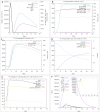Applying high throughput and comprehensive immunoinformatics approaches to design a trivalent subunit vaccine for induction of immune response against emerging human coronaviruses SARS-CoV, MERS-CoV and SARS-CoV-2
- PMID: 33509045
- PMCID: PMC7852294
- DOI: 10.1080/07391102.2021.1876774
Applying high throughput and comprehensive immunoinformatics approaches to design a trivalent subunit vaccine for induction of immune response against emerging human coronaviruses SARS-CoV, MERS-CoV and SARS-CoV-2
Abstract
Coronaviruses (CoVs) cause diseases such as severe acute respiratory syndrome (SARS), Middle East respiratory syndrome (MERS), and coronavirus disease 2019 (COVID-19). Therefore, this study was conducted to combat major CoVs via a trivalent subunit vaccine, which was engineered by implementing sequences of spike (S) protein, nucleocapsid (N), envelope (E), membrane (M) protein, non-structural protein (nsp) 3, and nsp8 antigens. The CTL, HTL, MHC I, and IFN-γ epitopes were predicted via CTLPRED, IEDB, and IFN epitope servers, respectively. Also, to stimulate strong helper T lymphocytes (HTLs) responses, Pan HLA DR-binding epitope (PADRE) was used. Also, for boosting the immune response, β-defensin 2 was added to the construct as an adjuvant. Furthermore, TAT was applied to the vaccine to facilitate the intracellular delivery. Finally, TAT, adjuvant, PADRE, and selected epitopes were appropriately assembled. Based on the predicted epitopes, a trivalent multi-epitope vaccine with a molecular weight of 74.8 kDa was constructed. Further analyses predicted the molecule to be a strong antigen, and a non-allergenic and soluble protein. Secondary and tertiary structures were predicted. Additionally, analyses validated the stability of the proposed vaccine. Molecular docking and molecular dynamics simulation (MDS) showed binding affinity and stability of the vaccine-TLR3 complex was favorable. The predicted epitopes demonstrated a strong potential to stimulate T and B-cell mediated immune responses. Furthermore, codon optimization and in silico cloning guaranteed increased expression. In summary, investigations demonstrated that this next-generation approach might provide a new horizon for the development of a highly immunogenic vaccine against SARS-CoV, MERS-CoV, and SARS-CoV-2.Communicated by Ramaswamy H. Sarma.
Keywords: Immunoinformatics; MERS‐CoV; SARS-CoV-2; SARS‐CoV; Subunit vaccine.
Conflict of interest statement
No potential conflict of interest was reported by the authors.
Figures















Similar articles
-
MERS virus spike protein HTL-epitopes selection and multi-epitope vaccine design using computational biology.J Biomol Struct Dyn. 2023;41(22):12464-12479. doi: 10.1080/07391102.2023.2191137. Epub 2023 Mar 19. J Biomol Struct Dyn. 2023. PMID: 36935104
-
A new multi-epitope vaccine candidate based on S and M proteins is effective in inducing humoral and cellular immune responses against SARS-CoV-2 variants: an in silico design approach.J Biomol Struct Dyn. 2024;42(22):12505-12522. doi: 10.1080/07391102.2023.2270699. Epub 2023 Oct 24. J Biomol Struct Dyn. 2024. PMID: 37874075
-
Reverse vaccinology assisted designing of multiepitope-based subunit vaccine against SARS-CoV-2.Infect Dis Poverty. 2020 Sep 16;9(1):132. doi: 10.1186/s40249-020-00752-w. Infect Dis Poverty. 2020. PMID: 32938504 Free PMC article.
-
COVID-19 Coronavirus Vaccine Design Using Reverse Vaccinology and Machine Learning.Front Immunol. 2020 Jul 3;11:1581. doi: 10.3389/fimmu.2020.01581. eCollection 2020. Front Immunol. 2020. PMID: 32719684 Free PMC article.
-
Recent trends in next generation immunoinformatics harnessed for universal coronavirus vaccine design.Pathog Glob Health. 2023 Mar;117(2):134-151. doi: 10.1080/20477724.2022.2072456. Epub 2022 May 12. Pathog Glob Health. 2023. PMID: 35550001 Free PMC article. Review.
Cited by
-
Immunomodulatory peptides: new therapeutic horizons for emerging and re-emerging infectious diseases.Front Microbiol. 2024 Dec 20;15:1505571. doi: 10.3389/fmicb.2024.1505571. eCollection 2024. Front Microbiol. 2024. PMID: 39760081 Free PMC article. Review.
-
Deep brain stimulation (DBS) as a therapeutic approach in gait disorders: What does it bring to the table?IBRO Neurosci Rep. 2023 May 19;14:507-513. doi: 10.1016/j.ibneur.2023.05.008. eCollection 2023 Jun. IBRO Neurosci Rep. 2023. PMID: 37304345 Free PMC article. Review.
-
Interferon therapy in patients with SARS, MERS, and COVID-19: A systematic review and meta-analysis of clinical studies.Eur J Pharmacol. 2021 Sep 5;906:174248. doi: 10.1016/j.ejphar.2021.174248. Epub 2021 Jun 12. Eur J Pharmacol. 2021. PMID: 34126092 Free PMC article.
-
Immunomodulatory and Allergenic Properties of Antimicrobial Peptides.Int J Mol Sci. 2022 Feb 24;23(5):2499. doi: 10.3390/ijms23052499. Int J Mol Sci. 2022. PMID: 35269641 Free PMC article. Review.
-
Promising strategy for developing mRNA-based universal influenza virus vaccine for human population, poultry, and pigs- focus on the bigger picture.Front Immunol. 2022 Oct 17;13:1025884. doi: 10.3389/fimmu.2022.1025884. eCollection 2022. Front Immunol. 2022. PMID: 36325349 Free PMC article. Review.
References
-
- Alexander, J., Fikes, J., Hoffman, S., Franke, E., Sacci, J., Appella, E., Chisari, F. V., Guidotti, L. G., Chesnut, R. W., Livingston, B., & Sette, A. (1998). The optimization of helper T lymphocyte (HTL) function in vaccine development. Immunologic Research, 18(2), 79–92. 10.1007/BF02788751 - DOI - PubMed
-
- Azhar, E. I., Lanini, S., Ippolito, G., & Zumla, A. (2016). The Middle East respiratory syndrome coronavirus–a continuing risk to global health security. In Emerging and re-emerging viral infections. Advances in Experimental Medicine and Biology, 972, 49–60. 10.1007/5584_2016_133. - DOI - PMC - PubMed
-
- Biragyn, A., Coscia, M., Nagashima, K., Sanford, M., Young, H. A., & Olkhanud, P. (2008). Murine beta-defensin 2 promotes TLR-4/MyD88-mediated and NF-kappaB-dependent atypical death of APCs via activation of TNFR2. Journal of Leukocyte Biology, 83(4), 998–1008. 10.1189/jlb.1007700 - DOI - PMC - PubMed
Publication types
MeSH terms
Substances
LinkOut - more resources
Full Text Sources
Other Literature Sources
Medical
Research Materials
Miscellaneous
